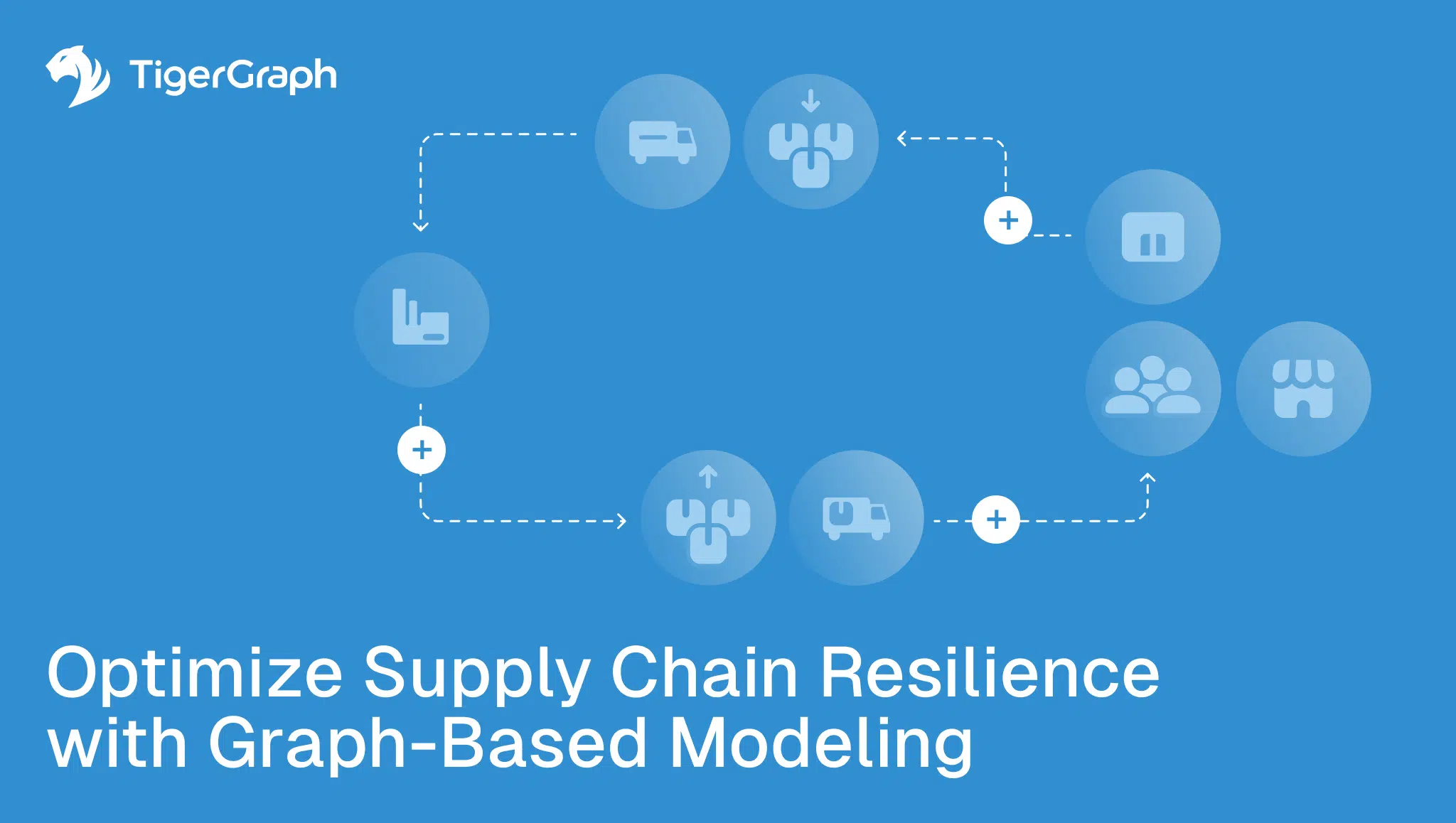Optimize Supply Chain Resilience with Graph-Based Modeling
Today’s supply chains are living, breathing networks of suppliers, sub-suppliers, SKUs, contracts, routes, regulations, weather, and risk. Optimizing them used to be about tracking static flows, but now it’s about modeling cascading effects and acting fast when conditions change.
In practice, that means moving beyond descriptive data and static optimization models and building systems that think in connections. This is exactly where graph databases, specifically TigerGraph, change the game.
Why Traditional Systems Can’t Keep Pace
Legacy platforms have typically been built on relational databases or siloed analytics tools. They were designed to manage recordkeeping, scheduling, and inventory control. But when disruptions hit, these tools struggle. They weren’t built to reason across tiers of dependencies or simulate what-if scenarios at the speed of supply chain volatility.
This has become a huge problem when there’s a port closure, weather delay, or raw material shortage, because these aren’t isolated events—they’re chain reactions. Conventional systems can’t trace their full impact without time-consuming joins, exports, or offline models. This results in delays, blind spots, and plans that fall apart under pressure.
This isn’t about speed alone—it’s about structural limitations that calls for a different approach to data modeling and decision-making.
The Graph Model: Purpose-Built for Disruption
TigerGraph models the supply chain as it truly exists: a web of entities connected by dynamic, real-time relationships. A shipment isn’t just a row in a table—it’s connected to parts, suppliers, carriers, forecasts, weather events, and downstream delivery timelines. By creating a real-time digital twin of the supply chain, TigerGraph enables companies to see not just static records but living systems of interdependent actions and risks. And a supplier isn’t just a vendor ID—it’s embedded in a network of dependencies, sub-suppliers, regional constraints, and contractual terms.
With graph, supply chain teams don’t just see events—they understand cause and effect. They can instantly ask:
- What’s the upstream source of this delay?
- Which customers and production lines will be affected?
- What alternatives exist right now, given current routes, stock levels, and carrier availability?
And they can get answers in milliseconds—because TigerGraph runs these queries directly in the graph, using native parallel processing across billions of connections.
From Optimization to Real-Time Decisioning
Traditional system optimization – finding the mathematically optimal choices for a given set of conditions – doesn’t do the job when conditions change frequently, because even small changes in the conditions can trigger big changes in answers. TigerGraph doesn’t just find a single “best” answer. Instead, it powers dynamic decisioning—equipping teams to explore multiple options, simulate cascading effects, and make informed tradeoffs in real time.
A global automotive manufacturer recently used TigerGraph to manage not just components and routes, but layered pricing tiers, contractual constraints, and manufacturing rules. Their legacy tools couldn’t process the complexity. With TigerGraph, they reduced scenario analysis from three weeks to under an hour—and could evaluate multiple plans, not just one.
That speed doesn’t just save time. It unlocks new capabilities like stress-testing contingency plans, pressure-testing sourcing strategies, and adapting to supply shocks in real-time, as they unfold.
Traceability in Both Directions
In modern supply chain management, visibility isn’t just about knowing what happened—it’s about understanding why it happened and what’s likely to happen next. That level of reasoning requires more than static dashboards or siloed reports. It demands a system that can model causality and consequence as fluid, connected events.
TigerGraph enables this with true bidirectional reasoning—making it possible to trace both upstream to root causes and downstream to projected impacts in real time.
When a disruption occurs—whether it’s a delayed carrier route, a port shutdown, or a missing compliance certificate—TigerGraph can instantly map the effect across the network. It reveals which inbound materials are now bottlenecked, which production orders are at risk, and which customer deliveries may be missed as a result. Equally important, it identifies which alternative suppliers, warehouses, or transport modes could absorb the impact and how that decision affects the rest of the chain.
This isn’t a theoretical performance. TigerGraph is purpose-built for complex, high-stakes environments like supply chain logistics. Its native parallel traversal engine lets teams explore multi-hop relationships across billions of entities without delay—surfacing dependencies, vulnerabilities, and contingencies within milliseconds.
Unlike traditional systems that rely on pre-joined views or data exports, TigerGraph executes queries in-graph, where the data and logic coexist. That means you’re not just retrieving records—you’re actively reasoning across the live structure of your operations.
Because supply chains evolve constantly, TigerGraph also adapts in real-time. Streaming ingestion ensures the graph is continuously updated with the latest data—from shipping APIs, ERP systems, IoT devices, and demand signals. Whether a new carrier becomes available, a regulatory update takes effect, or an inventory transfer is initiated, that information becomes immediately actionable. And with dynamic schema evolution, the graph model adjusts without interruption. New nodes, new constraints, new data sources—integrated instantly, without downtime or reconfiguration.
Together, these capabilities form more than just a data layer. TigerGraph becomes an operational reasoning engine, giving supply chain teams the ability to run complex “what-if” scenarios, assess cascading impacts, and make decisions that are not just faster—but smarter.
While the cost savings are real—reducing stockouts, rerouting around disruption, eliminating manual firefighting—the deeper value is strategic. It’s about operating with agility in a world of uncertainty. With TigerGraph, organizations gain the power to see around corners, act with context, and shift from reactive execution to proactive control.
It’s not simply an upgrade to your tech stack. It’s a shift in how your supply chain thinks.
From Reactive to Resilient—At Enterprise Scale
Disruption is no longer the exception—it’s the operating condition. There are constant geopolitical shifts, extreme weather, supplier insolvency and regulatory swings, placing supply chains in a constant state of adjustment. What defines a resilient enterprise isn’t whether it can avoid disruption—but whether it can understand it in context and respond faster than the fallout.
TigerGraph delivers that resilience by transforming complexity into clarity. It empowers organizations to stop chasing symptoms and start anticipating impact—to simulate multiple response paths in real time and choose the one that preserves cost, service levels, and trust.
This isn’t about reacting faster. It’s about reasoning deeper—under pressure, at scale, and with confidence.
For supply chain leaders, it’s not enough to have data. You need a system that can think—in connections, in context, and in real time. That’s the graph advantage—and it’s exactly what TigerGraph was built to deliver. Reach out and we’ll show you how it’s done!

